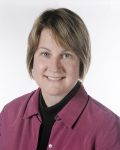 Brown University Professor Karen M. Fischer receives the Reid Medal for her pioneering research on Earth’s upper mantle structure and dynamics, the structure and evolution of continental lithosphere, and the dynamics of subduction systems.
Brown University Professor Karen M. Fischer receives the Reid Medal for her pioneering research on Earth’s upper mantle structure and dynamics, the structure and evolution of continental lithosphere, and the dynamics of subduction systems.
She is “an outstanding seismologist who has conducted many observational and modeling studies of the Earth’s seismic structure, illuminating dynamic mantle-flow processes in subduction zones, near the core-mantle boundary, and at the base and within the continental lithosphere,” said Donald W. Forsyth, James Manning Professor Emeritus at Brown, who nominated Fischer for the medal.
Fischer and her students conducted groundbreaking research on the boundary between the lithosphere (the more rigid outermost layer of the Earth) and the asthenosphere (a hotter and weaker part of the upper mantle). Their analysis of seismic waves helped to determine limits on the thickness and magnitude of this transition, and how it can be explained by gradients in mantle rock properties such as temperature, chemical composition and partial melt. Fischer also helped characterize zones, called mid-lithosphere discontinuities, within the thick lithosphere beneath the oldest continental crust, suggesting that they likely represent layers rich in “frozen-in” melt and mantle altered by fluids.
Fischer is widely recognized for her contributions to characterizing seismic anisotropy (where the velocity of seismic waves depends on the direction they propagate and the direction they vibrate) which have helped to identify and analyze patterns of mantle flow beneath continents and in subduction zones, where one tectonic plate moves underneath another. Her work in subduction zones has established evidence for three-dimensional asthenospheric flow, demonstrating that mantle flow dynamics are more nuanced than simple entrainment by the subducting plate.
Fischer has been a leader on four major deployments of portable seismometers, including the Missouri-to-Massachusetts (MOMA), the Florida-to-Edmonton (FLED), the Southeastern Suture of the Appalachian Margin Experiment (SESAME) arrays in North America and the TUCAN array under Costa Rica and Nicaragua. These experiments have provided an invaluable look at the crust and upper mantle in these regions, helping researchers understand the evolution of large-scale continental structure and how the dynamics of subduction interact with melt generation and transport to arc volcanoes, among other topics.
Fischer received her B.S. degree in geology and geophysics from Yale University in 1983 and her Ph.D. in geophysics from the Massachusetts Institute of Technology in 1989. Among her key leadership positions in the field, Fischer served multiple terms on the Incorporated Research Institutions for Seismology (IRIS) Board of Directors, most recently from 2016 to 2018, and as president of the Seismology Section of the American Geophysical Union (AGU) from 2013 to 2014.
She was also the first physical scientist at Brown University to receive the prestigious Royce Family Professorship, which recognizes excellence in teaching.
